Scotland's People Annual Report: Results from 2012 Scottish Household Survey
A National Statistics publication for Scotland, providing reliable and up-to-date information on the composition, characteristics, behaviour and attitudes of Scottish households and adults across a number of topic areas including local government, neighbourhoods and transport.
10 Health and Caring
Introduction and Context
Improving health is one of the Scottish Government's five strategic objectives:[68] Help people to sustain and improve their health, especially in disadvantaged communities, ensuring better, local and faster access to health care.
This is supported by the national outcome: 'we live longer, healthier lives'. A series of national indicators and targets has been devised to help assess progress towards achieving these national outcomes and strategic objectives. A number of these indicators are directly related to health and health-related behaviours. For example, the following target was set in relation to smoking: 'Reduce the percentage of adults who smoke'. The Scottish Household Survey (SHS) was used to monitor progress towards this target.
Although other sources of data on health in Scotland exist, such as the Scottish Health Survey (SHeS)[69], the long time-series and relatively large sample sizes available from the SHS mean that it is currently better placed than other surveys to monitor progress towards the smoking reduction target and to provide data on self-assessed health status to proxy healthy life expectancy. These measures are both explored in this chapter, alongside the prevalence of long-standing illness or disability in households in Scotland and provision of regular care and support.
The section on adult smoking looks at trends in smoking prevalence between 1999 and 2012 and examines the influence of age, sex and deprivation. The health and caring experiences of men and women are examined, as well as consideration of who is providing such care. The influence of other factors such as housing tenure, household income and area deprivation is also explored.
Main Findings
- Less than one quarter (23%) of adults smoked in 2012 which continues a general downwards trend in the proportion of adults who smoke. The 2012 proportion is a 0.4 percentage point reduction on 2011 and 7.8 percentage point reduction on 1999.
- Typically, more men than women smoke (24% and 21% respectively), with the gap widest (five percentage points) between the ages of 35 and 44 years.
- Adults in the 15% most deprived areas of Scotland are considerably more likely than those in the rest of Scotland to say that they are current smokers (37% and 20% respectively) though the gap continues to narrow year on year.
- Around one third of households in Scotland (34%) contain at least one person with a long-standing illness, health problem or disability. Owner occupier households (29%) and those who rent from the private sector (22%) are less likely to contain someone with long-standing health problems or disabilities than those living in the social rented sector (54%) or other tenure type.
- Just under one-in-ten people in Scotland (8.5%) look after or give any regular help or support to family members, friends, neighbours or others because of health issues;
- Around three quarters of adults (74%) say their own health is either 'very good' or 'good', compared to 7% of those saying it is 'bad' or 'very bad'.
- People living in the 15% most deprived of areas in Scotland are more likely to say their health is poor compared with those living elsewhere (12%, compared with 6%).
Smoking in Adults
Legislation to prohibit smoking in public places came into effect in late March 2006. The primary intention of the legislation was to reduce the harm from environmental tobacco smoke in the general population and, in particular, among employees exposed to smoke in the course of their work (e.g. bar workers). The legislation might, as an additional consequence, have encouraged some people to give up smoking, though there is no apparent change in the overall trend through that period.
Figure 10.1 shows the trend in proportion of adults saying they smoke between 1999 and 2012, with smoking among adults seeing a gradual decline from 30.7% in 1999 to 22.9% in 2012.
Figure 10.1: Whether respondent smokes by year
1999-2012 data, Adults (2012 base: 9,890)
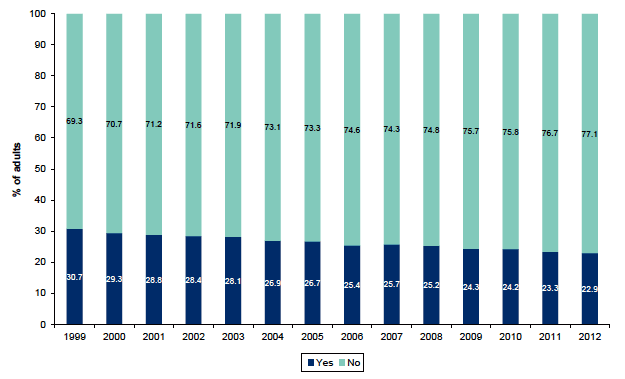
Figure 10.1 shows that the smoking rate declined every year between 1999 and 2012, except in 2007 where there was a slight increase. The average reduction across the period is around half a percentage point each year.
There are apparent differences in the proportion of men and women who smoke, along with the prevalence of smoking in different age groups (Figure 10.2). Typically, more men than women smoke (24% and 21% respectively), with the gap widest (five percentage points) between the ages of 35 and 44 years. Whilst younger people more commonly smoke, there is a pronounced drop in smoking prevalence among those aged over 60 years. Among the 60-74 year old group, the proportion smoking is down to 1 in 5 (19%), reducing to less than 1 in 10 among those aged 75 or over (7%).
Figure 10.3 shows the variation in smoking behaviour by economic status, with those still at school least commonly smoking (3%) followed by those permanently retired from work (14%). The adults who most commonly smoke are those unable to work due to short-term ill-health (60%), those unemployed and seeking work (51%) and those who are permanently sick or disabled (51%). These overall patterns remain unchanged from the estimates reported from 2011.
Figure 10.2: Percentage of respondents who smoke by age and gender
2012 data, Adults (base: 4,410; minimum: 370)
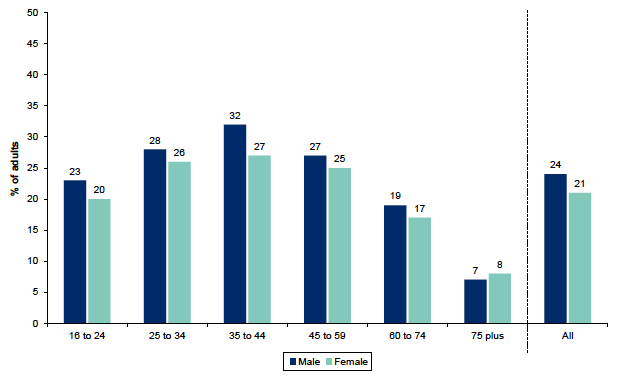
Figure 10.3: Percentage of respondents who smoke by economic status
2012 data, Adults (base: 9,890; minimum: 60)
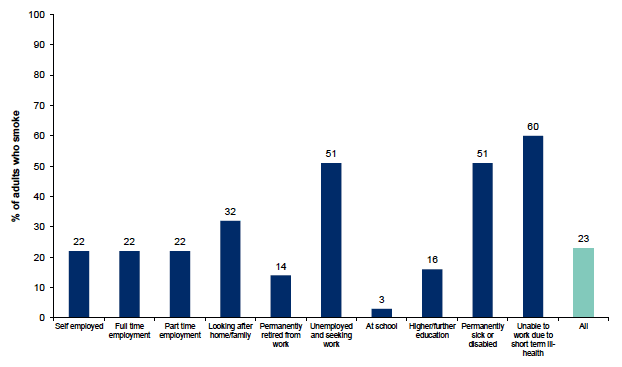
Figure 10.4 illustrates the relationship between smoking prevalence and area deprivation.[70] Adults in the 15% most deprived areas of Scotland are considerably more likely than those in the rest of Scotland to say that they are current smokers (37% and 20% respectively). Looking across from the 10% most deprived to the 10% least deprived areas shows a trend of generally decreasing smoking prevalence rates. Around one in ten adults living in the 10% least deprived areas of Scotland smoke, compared to around two-fifths of adults (39%) in the most deprived areas.
Figure 10.4: Percentage of respondents who smoke by Scottish Index of Multiple Deprivation
2012 data, Adults (base: 9,890; minimum: 810)
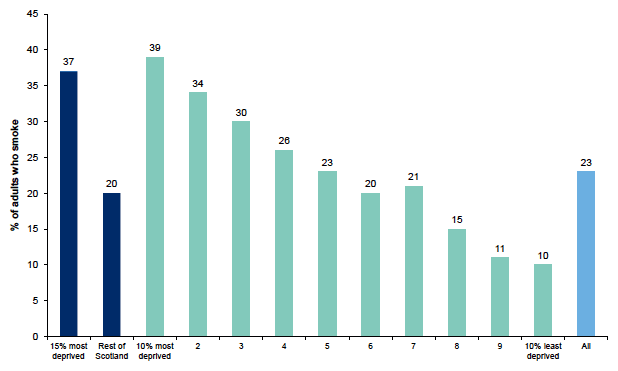
Figure 10.5 compares the self-assessed health status of non-smokers and smokers. Smoking causes and exacerbates a number of chronic respiratory diseases and cardio-vascular disease, and can worsen the health of people with long-term conditions such as asthma. Smokers are less likely than non-smokers to describe their health as 'good' or 'very good' (62% and 77% respectively) while 11% of smokers say their health is 'bad' or 'very bad' compared with 5% of non-smokers. The determinants of self perceived health are examined further towards the end of the chapter.
Figure 10.5: Percentage of respondents who smoke by self perception of health
2012 data, Adults (base: 9,890; minimum: 2,380)
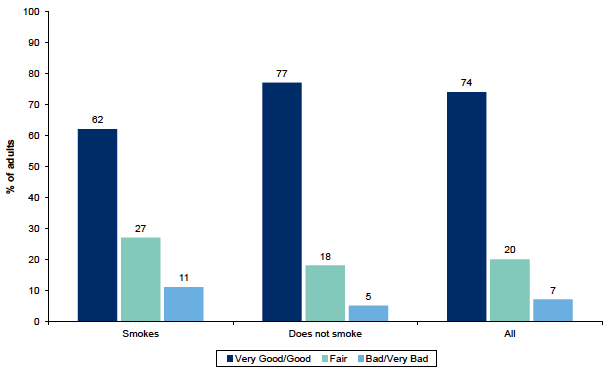
Long-standing Illness or Disability
The SHS asks participants whether anyone in their household, including children, has: "Any long-standing illness, health problem or disability that limits your/their daily activity or the kind of work that you/they can do? By disability as opposed to ill-health, I mean a physical or mental impairment, which has a substantial and long-term adverse effect on their ability to carry out normal day to day activities."
The question is therefore a subjective measure of long-standing illness, disability and health problems and is not subject to any verification. In addition, this wording does not capture all forms of disability covered by the legal definition within the Disability Discrimination Act 2005, though this is being explored for future years of the survey.[71]
Figure 10.6 shows that around a third of households in Scotland (34%) contain at least one person with a long-standing illness, health problem or disability. This figure covers all members of the household, including children. Households comprised of older people are more likely to contain someone with a long-standing health problem or disability, with over half of 'older smaller'[72] (51%) and 'single pensioner' households (53%) doing so compared with only 17% of small family households.
Figure 10.6: Households where someone in the household has a long-standing illness, health problem or disability by household type
2012 data, Households (base: 10,640; minimum: 610)
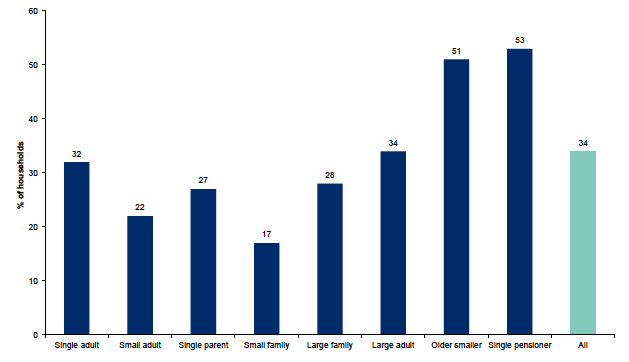
In Figure 10.7 it can be seen that the proportion of households which contain someone with a long-standing illness, health problem or disability decreases as the net annual household income (of the highest income householder and their spouse or partner) increases. For example, more than two-fifths of households with an income of less than £20,000 have someone with some of form of long-standing illness, health problem or disability. The corresponding figure for households with a net annual income of over £40,000 is 13%. These findings are partly explained by the income profile of older households, which suggest that older smaller households and single pensioner households have lower income than other households.
Figure 10.7: Households where someone in the household has a long-standing illness, health problem or disability by net annual household income
2012 data, Households (base: 20,260; minimum: 310)
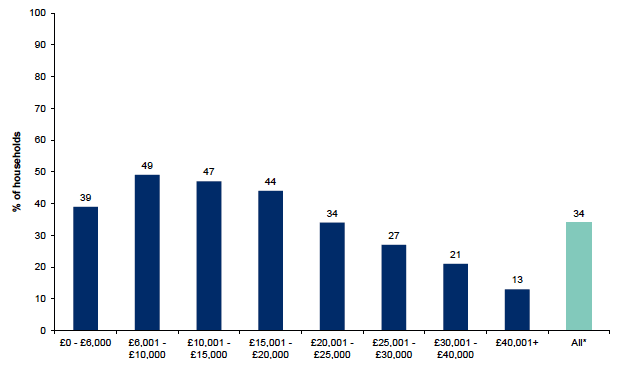
Household income in the SHS is that of the highest income householder and their partner only. Includes all adults for whom household income is known or has been imputed. Excludes refusals/don't know responses.
Owner occupier households (29%) and those who rent from the private sector (22%) are less likely to contain someone with long-standing health problems or disabilities than those living in the social rented sector (54%) or other tenure types (Figure 10.8). The discussion above noted that many pensioners and single pensioners in particular have low incomes. However, although they can have lower incomes, older people are more likely to be owner occupiers than people in other age groups, so the association between disability, health status and living in the social rented sector is likely to be explained by factors other than just the age of the householders.
Figure 10.9 shows the age and gender profile of those people with a long-term health issue or disability. This shows that females are slightly more likely to have a long-term health issue or disability across most of the age groups. Overall, 17% of males have a health problem compared to 19% of females.
There is some evidence of a greater concentration of males with health issues or disabilities in their youth, with a slightly higher proportion of males than females aged less than twenty reported as having a disability or long-term illness. The analysis in Figure 10.9 differs from that presented in 2011 as it now looks at age within gender breakdowns (e.g. 7% of males aged 0 to 9 have a health problem) rather than looking at age within gender and health problems at the same time (e.g. 2011 estimates showed that 4% of all males with some form of long-term health issue or disability were aged 0 to 9).
Figure 10.8: Households where someone in the household has a long-standing illness, health problem or disability by tenure of household
2012 data, Households (base: 10,640; minimum: 160)
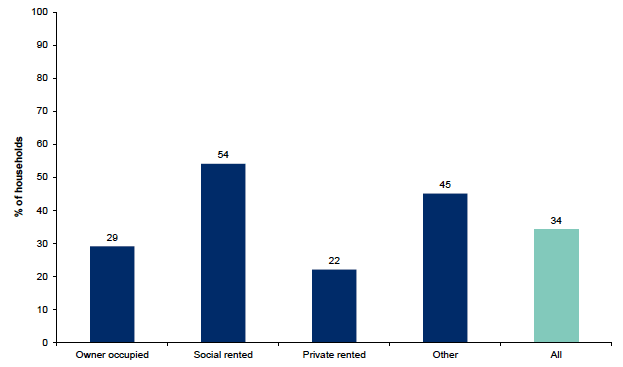
Figure 10.9: Household members with a long-standing limiting illness, health problem or disability by age within gender
2012 data, Household members with a disability and/or long-term illness (base: 23,210; min: 11,260)

Care Provision within the home
This section looks at whether household members in Scotland look after or give any regular help or support to other family members, friends, neighbours or others because of either long-term physical, mental ill-health or disability, or problems related to old age. In Table 10.1, social renters are the most prevalent household type to contain an unpaid carer providing care to others (16%). In Scotland overall, around 13% of households contain someone providing unpaid care to others.
Table 10.1: Households containing someone who provides regular unpaid help or care to others by tenure of household
Column percentages, 2012 data
| Households | Owner occupied | Social rented | Private rented | Other | All |
|---|---|---|---|---|---|
| Yes | 13 | 16 | 7 | 14 | 13 |
| No | 87 | 84 | 93 | 86 | 87 |
| Total | 100 | 100 | 100 | 100 | 100 |
| Base | 6,830 | 2,410 | 1,250 | 160 | 10,640 |
Looking at the provision of unpaid care by adults in Scotland (Table 10.2), just over nine-in-ten adults (91.5%) don't provide any unpaid care whilst 8.5% of adult do provides care. This analysis differs from that presented in 2011 where the SHS was able to differentiate between care provision provided either within or outwith the household.
Table 10.2: Provision of unpaid care by adults (withing or outwith the household)
Column percentages, 2012 data
| Adults | |
|---|---|
| Does provide care | 8.5 |
| Don't provide unpaid care | 91.5 |
| Total | 100 |
| Base | 9,890 |
Self Perception of Health
Just under three quarters of adults (74%) of adults say their own health is either 'very good' or 'good', compared to 7% of those saying it is 'bad' or 'very bad' (see Table 10.3). There is little difference in self perception of health between males and females. There are differences in health when looking at age however, with those 60 and above much more likely to say their health is in general 'bad' or 'very bad' (around one in ten adults aged 60 and over).
Table 10.3: Self perception of health by gender and age
Column percentages, 2012 data
| Adults | Male | Female | 16 to 24 | 25 to 34 | 35 to 44 | 45 to 59 | 60 to 74 | 75 plus | All |
|---|---|---|---|---|---|---|---|---|---|
| Very Good/Good | 74 | 73 | 88 | 85 | 80 | 71 | 61 | 51 | 74 |
| Fair | 19 | 21 | 10 | 12 | 16 | 20 | 29 | 36 | 20 |
| Bad/Very Bad | 7 | 6 | 2 | 3 | 4 | 9 | 10 | 13 | 7 |
| Total | 100 | 100 | 100 | 100 | 100 | 100 | 100 | 100 | 100 |
| Base | 4,410 | 5,490 | 780 | 1,380 | 1,550 | 2,460 | 2,440 | 1,290 | 9,890 |
There is a relationship between income and perceived health - one in which age may be a contributory factor though - with one in ten of those with a net annual household income of £20,000 or less saying they have 'bad' or 'very bad' health compared with 3% or less where income in excess of £30,000 (Table 10.4).
Table 10.4: Self perception of health by net annual household income
Column percentages, 2012 data
| Adults | £0 - £6,000 | £6,001 - £10,000 | £10,001 - £15,000 | £15,001 - £20,000 | £20,001 - £25,000 | £25,001 - £30,000 | £30,001 - £40,000 | £40,001+ | All |
|---|---|---|---|---|---|---|---|---|---|
| Very Good/Good | 68 | 57 | 63 | 64 | 74 | 79 | 83 | 88 | 74 |
| Fair | 23 | 29 | 27 | 25 | 19 | 17 | 14 | 11 | 20 |
| Bad/Very Bad | 9 | 14 | 10 | 11 | 7 | 4 | 3 | 1 | 7 |
| Total | 100 | 100 | 100 | 100 | 100 | 100 | 100 | 100 | 100 |
| Base | 290 | 1,100 | 1,870 | 1,540 | 1,260 | 900 | 1,190 | 1,380 | 9,530 |
Household income in the SHS is that of the highest income householder and their partner only. Includes all adults for whom household income is known or has been imputed. Excludes refusals/don't know responses.
Looking at tenure (Table 10.5), those adults who live in the social rented sector are more likely to say their health in general has been 'bad' or 'very bad' (16%) as compared to those from owner occupied households or the private rented sector (4%).
Table 10.5: Self perception of health by tenure of household
Column percentages, 2012 data
| Adults | Owner occupied | Social rented | Private rented | Other | All |
|---|---|---|---|---|---|
| Very Good/Good | 78 | 56 | 82 | 63 | 74 |
| Fair | 18 | 28 | 14 | 25 | 20 |
| Bad/Very Bad | 4 | 16 | 4 | 12 | 7 |
| Total | 100 | 100 | 100 | 100 | 100 |
| Base | 6,320 | 2,270 | 1,160 | 140 | 9,890 |
Table 10.6 shows that people living in the 15% most deprived of areas in Scotland[73] are more likely to say their health is poor compared with those living elsewhere (12%, compared with 6%). When considering differences in perception of health by deprivation deciles (from the 10% most deprived areas to the 10% least deprived), we see a gradual increase in the proportion saying their health is good. Around two thirds of adults living in the 30% most deprived areas in Scotland say their health is 'good' or 'very good', which compares against around four fifths for those in the 30% least deprived areas (84% in the 10% least deprived areas).
Table 10.6: Self perception of health by Scottish Index of Multiple Deprivation
Column percentages, 2012 data
| Adults | < 10% most deprived | 10% least deprived > | |||||||||
|---|---|---|---|---|---|---|---|---|---|---|---|
| 1 | 2 | 3 | 4 | 5 | 6 | 7 | 8 | 9 | 10 | Scot- land |
|
| Very Good/Good | 59 | 64 | 70 | 70 | 74 | 76 | 78 | 78 | 82 | 84 | 74 |
| Fair | 27 | 26 | 21 | 22 | 20 | 18 | 16 | 18 | 16 | 13 | 20 |
| Bad/Very Bad | 14 | 10 | 9 | 8 | 6 | 6 | 5 | 3 | 3 | 2 | 7 |
| Total | 100 | 100 | 100 | 100 | 100 | 100 | 100 | 100 | 100 | 100 | 100 |
| Base | 960 | 920 | 970 | 1,110 | 1,070 | 1,080 | 1,090 | 1,030 | 860 | 810 | 9,890 |
| Adults | 15% most deprived | Rest of Scotland | Scotland |
|---|---|---|---|
| Very Good/Good | 61 | 76 | 74 |
| Fair | 26 | 19 | 20 |
| Bad/Very Bad | 12 | 6 | 7 |
| Total | 100 | 100 | 100 |
| Base | 1,400 | 8,490 | 9,890 |
Figure 10.10 shows that smokers are less likely than non-smokers to describe their health as good, with 77% of non-smokers describing their health as 'good' or 'very good' as against 62% for smokers. However, it is unclear how smoking works alongside age - since older people less commonly smoke but more commonly report not having good health, while smokers tend to be younger but also tend to report less good health.
It is also evident that differences exist in self perception of health depending on whether people have undertaken any physical activity in the past four weeks. The vast majority of adults who have undertake some form of physical activity (81%) consider their health to be 'good' or 'very good', with only 3% saying it was 'bad' or 'very bad'. In contrast, 18% of those people who have undertaken no physical activity the past four weeks described their health as 'bad' or 'very bad'.
Figure 10.10: Self perception of health by smoking, illness or disability and whether has done physical activity in the past four weeks
2012 data, Adults (base: 9,890; minimum: 1,990)
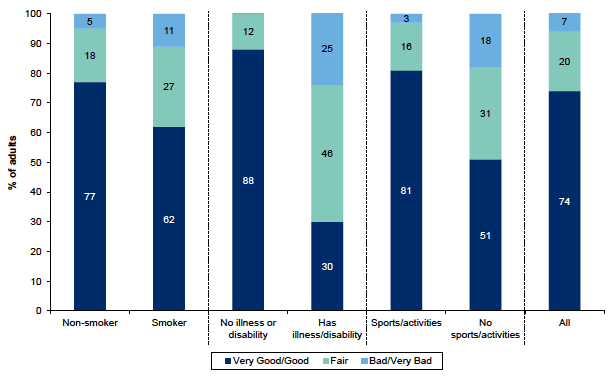
It should be noted that the SHS previously collected information on life satisfaction. From January 2012, this was replaced by the Short Warwick-Edinburgh Mental Well-being Scale (SWEMWBS). This falls part of the core question set as discussed in Chapter 1 of this report. Differences in results between those from the SHS and the Scottish Health Survey are still being reviewed before SHS results can be released. A supplementary release will be included on the SHS website in due course.
Contact
Email: Nic Krzyzanowski
There is a problem
Thanks for your feedback